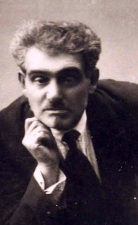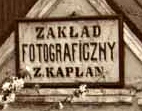|
Zalman Kaplan became
a photographer less than 40 years after the introduction of the art in 1839
(by Daguerre in France) and just a few short years after the invention of
the glass negative which allowed both retouching and the printing of
multiple prints on paper.
|
|
|
 |
|
Zalman Kaplan |
|
| |
|
Kaplan was a
master of posing and lighting. His camera room had two glass sides and a
glass roof. Most portraits were made by natural light in Europe and the
U.S. until after WWI. Kaplan initially used a large view camera and plates
about 6 x 8 inches. Prints were made on albumen paper, the emulsion
suspended in an eggwhite mixture. Later, he changed to rich, browntoned
carte postale paper from Germany. Contact printing was also the rule. The
retouched negative was sandwiched with a piece of photographic paper the
same size as the negative and exposed to the sun. Compared to other
photographs of the era -- both in Europe and the U.S. -- Kaplan Portraits
are in the superior quality category. His posing was, for its day, more
relaxed than most -- in spite of the one to three second exposures. The
outdoor poses are very casual and ahead of their time. The surviving Kaplan
pictures -- even those almost 100 years old -- are unfaded due to extra
steps taken to fix and brown or goldtone the prints. Faces, even in large
groups, were painstakingly retouched on the negative so each person looked
his or her best. It is easy to see that Kaplan (and his subjects) had a
deep sense of history for each image that was recorded.
|
|
|
|
 |
|
Zalman Kaplan
Studio |
|
|
| |
|
In towns
throughout Europe -- and the U.S. -- the photographer's studio was
frequented by all economic groups. Some came to simply record themselves
looking their best or to have a portrait to give to loved ones. Some came
to commemorate an event like a marriage, a visit from an out-of-town
relative, or a family member going away. Or, groups of good friends just
came to be photographed together for fun. Amateur photography was rare so
studios were very busy. Daily visits to see the new pictures in the Kaplan
showcases became a tradition in Szczuczyn. With the military as an early
client, Kaplan often photographed on location both outdoors and inside. He
completed large assignments of photographing area monuments and buildings
for the Czar's army and was presented a gold watch by the commander for the
superior job. Kaplan also sold photographic postcards of his town to
tourists and army personnel. He also documented and sold group photographs
of classes for church, secular, and Jewish schools. His group portraits of
Jewish organizations and committees photographed solely by window light
inside buildings are remarkable even by today's standards.
Of the tens of
thousands of Kaplan photographs made between the 1890's and 1941, three main
groups have survived. First, there are family portraits, school, and club
photographs that remain with Polish families in Szczuczyn. Many of those,
however, were destroyed in World War II -- as were those in the possession
of the city government. The entire Kaplan negative archive was destroyed
during the Holocaust. Next are the photographs taken for Jews leaving
Szczuczyn before World War II for the U.S., Palestine, Canada, Mexico, many
South and Central American countries, Australia, New Zealand, and
elsewhere. Today, with that generation all but gone those pictures are the
only way we can see how they looked and how they lived. Included in this
group are the photographs brought to Canada by the Kaplan sons and those
later mailed to them by their family in Szczuczyn.
A third group
that is now being discovered are the Kaplan photographic postcards mailed by
World War I German soldiers to their families and a few in early Polish
history books. |